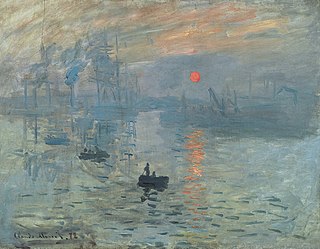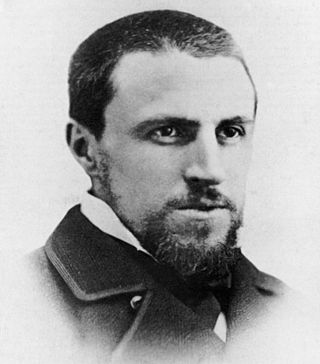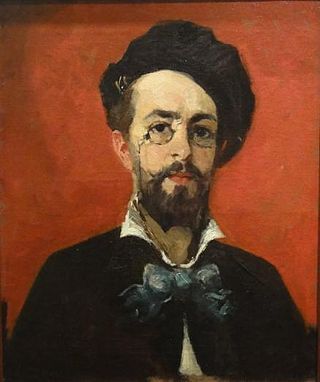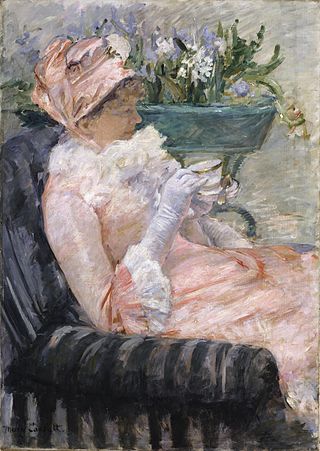
Impressionism was a 19th-century art movement characterized by relatively small, thin, yet visible brush strokes, open composition, emphasis on accurate depiction of light in its changing qualities, ordinary subject matter, unusual visual angles, and inclusion of movement as a crucial element of human perception and experience. Impressionism originated with a group of Paris-based artists whose independent exhibitions brought them to prominence during the 1870s and 1880s.

The Musée d'Orsay is a museum in Paris, France, on the Left Bank of the Seine. It is housed in the former Gare d'Orsay, a Beaux-Arts railway station built between 1898 and 1900. The museum holds mainly French art dating from 1848 to 1914, including paintings, sculptures, furniture, and photography. It houses the largest collection of Impressionist and post-Impressionist masterpieces in the world, by painters including Berthe Morisot, Claude Monet, Édouard Manet, Degas, Renoir, Cézanne, Seurat, Sisley, Gauguin, and van Gogh. Many of these works were held at the Galerie nationale du Jeu de Paume prior to the museum's opening in 1986. It is one of the largest art museums in Europe.

Gustave Caillebotte was a French painter who was a member and patron of the Impressionists, although he painted in a more realistic manner than many others in the group. Caillebotte was known for his early interest in photography as an art form.
Events from the year 1877 in art.

Luncheon of the Boating Party French: Le Déjeuner des canotiers is an 1881 painting by French impressionist Pierre-Auguste Renoir. Included in the Salon in 1882, it was identified as the best painting in the show by three critics. It was purchased from the artist by the dealer-patron Paul Durand-Ruel and bought in 1923 from his son by industrialist Duncan Phillips, who spent a decade in pursuit of the work. It is now in The Phillips Collection in Washington, D.C. It shows a richness of form, a fluidity of brush stroke, and a flickering light.

John Kirk Train Varnedoe was an American art historian, the Chief Curator of Painting and Sculpture at the Museum of Modern Art from 1988 to 2001, Professor of the History of Art at the Institute for Advanced Study in Princeton, New Jersey, and Professor of Fine Arts at the New York University Institute of Fine Arts.

Paris Street; Rainy Day is a large 1877 oil painting by the French artist Gustave Caillebotte (1848–1894), and is his best known work. It shows a number of individuals walking through the Place de Dublin, then known as the Carrefour de Moscou, at an intersection to the east of the Gare Saint-Lazare in north Paris. Although Caillebotte was a friend and patron of many of the impressionist painters, and this work is part of that school, it differs in its realism and reliance on line rather than broad brush strokes.

Vue de toits (Effet de neige) (English title: View of rooftops (Effect of snow)) is an oil painting by French impressionist Gustave Caillebotte executed in the winter of 1878 and 1879. The canvas measures 81 by 65 centimetres (32 in × 26 in). It was originally gifted by Caillebotte's brother in 1894 to the Musée du Luxembourg, then transferred to the Musée du Louvre in 1929. In 1947, it was moved to the Galerie nationale du Jeu de Paume, which held many impressionist works in France after World War II. In 1986, it was transferred again to the Musée d'Orsay in Paris, where it is currently displayed. The painting is one of the few Caillebotte works that have remained in public view since the artist's death in 1894.

Les raboteurs de parquet is an oil painting by French Impressionist Gustave Caillebotte. The canvas measures 102 by 146.5 centimetres. It was originally given by Caillebotte's family in 1894 to the Musée du Luxembourg, then transferred to the Musée du Louvre in 1929. In 1947, it was moved to the Galerie nationale du Jeu de Paume, and in 1986, it was transferred again to the Musée d'Orsay in Paris, where it is currently displayed.

Les Orangers is an oil painting by French impressionist Gustave Caillebotte. The canvas measures 155 by 117 centimetres. It was acquired by Audrey Jones Beck and was part of a collection that was on a long-term loan to the Museum of Fine Arts, Houston, before the collection was donated to the museum in 1999. The painting now hangs in the museum building named for Beck.

Le Pont de l'Europe is an oil painting by French impressionist Gustave Caillebotte completed in 1876. It is held by the Musée du Petit Palais in Geneva, Switzerland. The finished canvas measures 125 by 181 centimetres.

Young Man at His Window is a painting of 1876 by the French Impressionist Gustave Caillebotte (1848–1894). The oil on canvas painting measures 117 by 82 centimetres. It is in the collection of the J. Paul Getty Museum in Los Angeles.

A Balcony in Paris is an oil-on-canvas painting by the French Impressionist painter Gustave Caillebotte. It was completed c. 1880–1881. The dimensions of the painting are 55.2 by 39 centimeters. It is housed in a private collection.

Frédéric Samuel Cordey (1854–1911) was a French landscape painter who was a part of the Impressionist movement. He was a close friend of Auguste Renoir, and had a personal fortune that allowed him to work according to his taste, regardless of the publicity and support provided by art dealers.

Homme au bain is an 1884 oil painting by French Impressionist Gustave Caillebotte.
Norma Broude is an American art historian and scholar of feminism and 19th-century French and Italian painting. She is also a Professor Emerita of art history from American University. Broude, with Mary Garrard, is an early leader of the American feminist movement and both have redefined feminist art theory.

Marguerite Charpentier was a French salonist and art collector who was one of the earliest champions of the Impressionists, especially Pierre-Auguste Renoir.

The American artist Mary Cassatt painted The Cup of Tea in Paris ca. 1879–1881. The painting depicts Mary’s sister Lydia Cassatt in a typical, upper class-Parisian ritual of afternoon tea. Scholars have observed that Cassatt’s choice to employ vivid colors, loose brushstrokes, and unique perspective to portray the scene makes it a quintessentially Impressionist painting.

Gare Saint-Lazare is a series of oil paintings by the French artist Claude Monet. The paintings depict the smoky interior of this railway station in varied atmospheric conditions and from various points of view. The series contains twelve paintings, all created in 1877 in Paris. This was Monet's first series of paintings concentrating on a single theme.

The Lady in White, also known as The Woman in White, is an 1880 oil-on-canvas painting by French artist Marie Bracquemond. It depicts a portrait of the artist's half-sister Louise Quivoron, who often served as a model for her paintings. It was one of three paintings of hers shown at the fifth Impressionist exhibition in April 1880. A previous painting, Woman in the Garden (1877), may have been a study for The Lady in White. It appears on a large canvas with subdued colors reminiscent of Jean-Baptiste-Camille Corot (1796–1875). Like the other Impressionists of the time, Bracquemond worked outside en plein air, mostly in her garden at Sèvres.


















